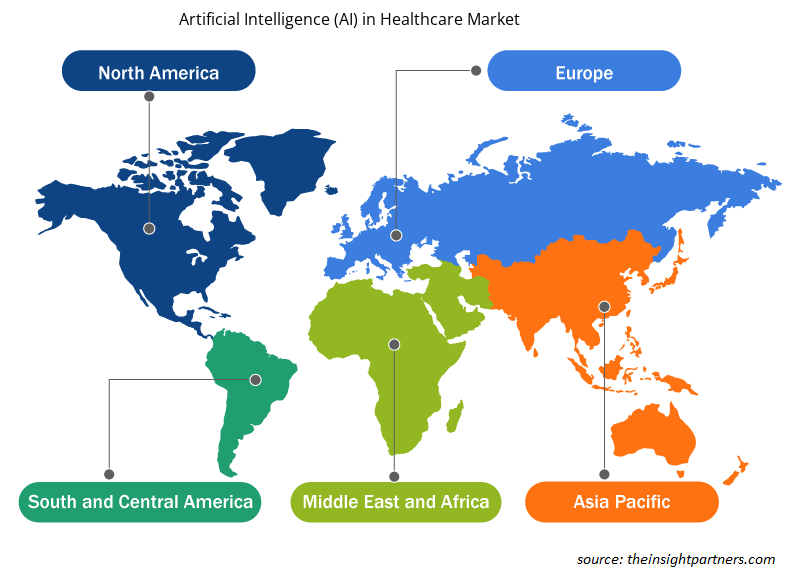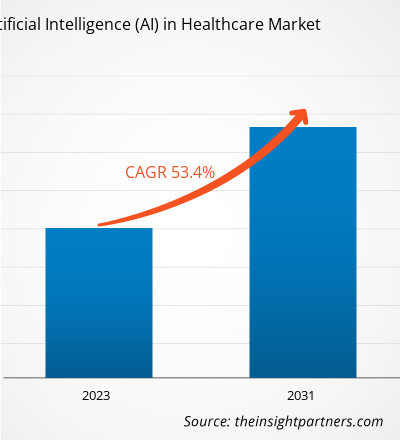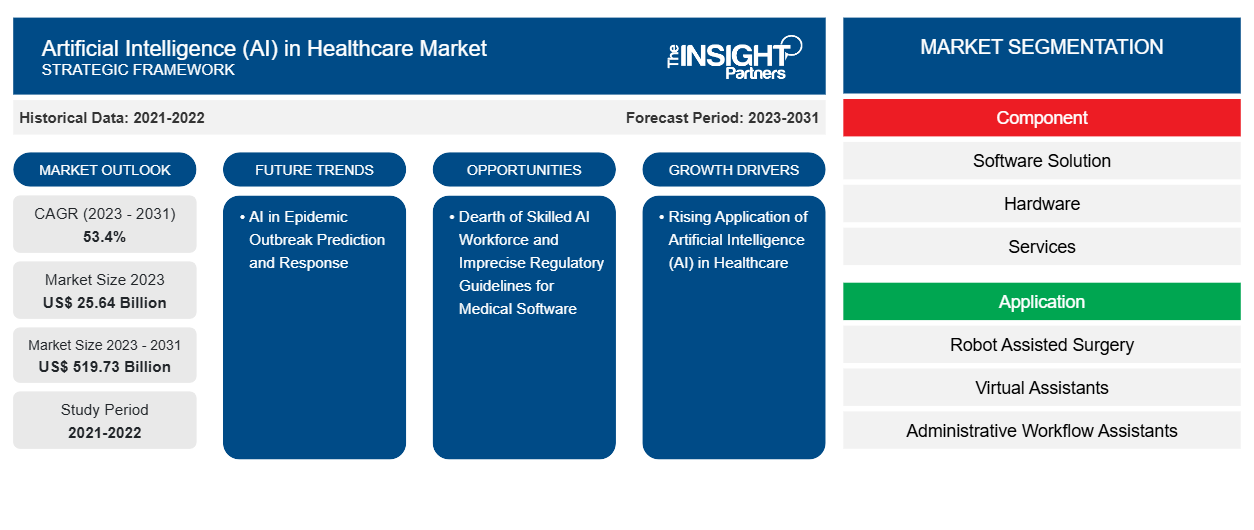医疗保健领域的人工智能 (AI) 市场规模预计将从 2023 年的 256.4 亿美元增至 2031 年的 5197.3 亿美元。预计 2023-2031 年期间该市场的复合年增长率将达到 53.4%。
在预测期内,人工智能自主服务机器人、人形机器人、实时疾病监测、传播趋势分析和可视化、感染率和感染趋势估计以及快速决策以确定有效治疗方法的发展可能仍是医疗保健市场人工智能 (AI) 的主要趋势。
医疗保健领域的人工智能(AI)市场分析
大量复杂的医疗数据集不断涌入,推动了医疗保健市场中的人工智能 (AI) 的发展。此外,通过最小化硬件成本,同时降低医疗成本和提高计算能力的需求也日益增加。此外,政府不断增加的举措及其合作也推动了市场的发展,以促进人工智能在医疗保健领域的实施,市场参与者的并购和投资组合扩张也不断增加。医护人员和患者之间存在不平衡。人工智能恢复了这种平衡,并推动了医疗保健市场中的人工智能 (AI) 的增长。精准医疗和临床试验流程的使用越来越多,需要人工智能,从而进一步推动市场的发展。增加对该领域研发的资金投入,有助于医疗保健市场中的人工智能 (AI) 的增长。
医疗保健领域的人工智能 (AI) 市场概览
人工智能在医疗保健领域有多种应用。它允许医生检索信息、解释扫描过程中捕获的图像并制定治疗计划。除了临床方面,人工智能还有利于研究活动。在公共卫生、创新、研究和技术进步的支持下,医学的进步显著降低了发病率和死亡率。医疗保健行业正在通过利用人工智能来提高生产力,同时减轻医疗保健专业人员的巨大负担,从而实现重大发展。政府和私人组织将人工智能纳入其研究工作,以加速发展。
定制此报告以满足您的需求
您可以免费定制任何报告,包括本报告的部分内容、国家级分析、Excel 数据包,以及为初创企业和大学提供优惠和折扣
-
获取此报告的关键市场趋势。这个免费样品将包括数据分析,从市场趋势到估计和预测。
医疗保健领域的人工智能 (AI) 市场驱动因素和机遇
加强跨行业伙伴关系和合作
跨行业合作带来了新的机器学习 (ML) 模型的引入,这些模型可以预测风险并提供认知帮助。这些合作伙伴关系是企业和社会关系中最具活力的实践之一,它们连接着公共、私营和非营利组织等各个部门。2023 年 10 月,西门子和微软合作推动人工智能在各个行业的应用。两家公司推出了西门子工业副驾驶,这是一款联合开发的人工智能助手,旨在改善制造业的人机协作。此外,西门子 Teamcenter 产品生命周期管理软件和 Microsoft Teams 的集成将为工业元宇宙的进一步发展铺平道路。2023 年 1 月,阿斯利康与 Qure.ai 合作,后者是一家开发用于解释放射图像的深度学习算法的开发商。此次合作将特别关注克服限制获取诊断工具的障碍,支持肺癌的早期发现,降低死亡率,并改善患者预后,特别是在中低收入国家。
新兴经济体潜力不断扩大
在医疗技术、医护人员和医疗资源有限的发展中国家,人工智能应用的影响可能会为解决当前的主要挑战提供一条颠覆性的道路。例如,印度理工学院 (IIT) 德里分校的研究人员开发了一种人工智能系统,利用胸部 X 光诊断结核病 (TB)。该系统可以在不到一分钟的时间内分析 X 光片中的结核病迹象,使其成为诊断偏远地区结核病的有力工具,因为这些地区的医护人员可能有限。在巴西,大多数城市都缺少皮肤科医生,即使是在大城市的郊区也是如此。顶级医院正在通过提供由人工智能筛查工具支持的远程皮肤病学服务来缩小获得医疗服务的差距。此外,使用人工智能技术可以降低医疗保健成本,使发展中国家的人们能够负担得起。
医疗保健市场中的人工智能(AI)报告细分分析
有助于医疗保健市场分析中人工智能 (AI) 衍生的关键部分是组件、应用程序和最终用户。
- 根据组件,医疗保健市场中的人工智能 (AI) 分为软件解决方案、硬件和服务。软件解决方案部分在 2023 年占据了最大的市场份额。
- 根据应用,市场细分为机器人辅助手术、虚拟助手、行政工作流程助手、联网机器、诊断、临床试验、欺诈检测、网络安全、剂量误差减少等。机器人辅助手术领域在 2023 年占据了最大的市场份额。
- 就最终用户而言,市场细分为医院和医疗保健提供商、患者、制药和生物技术公司、医疗保健付款人等。医院和医疗保健提供商细分市场在 2023 年占据了市场主导地位。
医疗保健领域人工智能 (AI) 市场份额(按地区)分析
医疗保健领域的人工智能(AI)市场报告的地理范围主要分为五个地区:北美、亚太地区、欧洲、中东和非洲、南美和中美。
北美在医疗保健人工智能 (AI) 市场中占据主导地位。北美市场的增长归因于医疗保健领域不断发展的数字基础设施、成熟的医疗保健行业以及患者对人工智能益处的认识不断提高。随着各种主要参与者的加入,北美医疗保健人工智能 (AI) 市场也可能会蓬勃发展。此外,医疗保健运营中采用数字工具来提高质量和降低成本,有助于北美在医疗保健人工智能 (AI) 市场中占据主导地位。预计亚太地区未来几年将实现最高复合年增长率。
医疗保健市场中的人工智能 (AI) 区域洞察
Insight Partners 的分析师详细解释了预测期内影响医疗保健市场人工智能 (AI) 的区域趋势和因素。本节还讨论了北美、欧洲、亚太地区、中东和非洲以及南美和中美洲的医疗保健市场细分和地理位置中的人工智能 (AI)。

- 获取医疗保健市场人工智能(AI)的区域特定数据
医疗保健市场中的人工智能 (AI) 报告范围
| 报告属性 | 细节 |
|---|---|
| 2023 年的市场规模 | 256.4 亿美元 |
| 2031 年市场规模 | 5197.3亿美元 |
| 全球复合年增长率(2023 - 2031) | 53.4% |
| 史料 | 2021-2022 |
| 预测期 | 2023-2031 |
| 涵盖的领域 |
按组件
|
| 覆盖地区和国家 |
北美
|
| 市场领导者和主要公司简介 |
|
市场参与者密度:了解其对商业动态的影响
医疗保健市场中的人工智能 (AI) 市场正在快速增长,这得益于最终用户需求的不断增长,这些需求源于消费者偏好的不断变化、技术进步以及对产品优势的认识不断提高等因素。随着需求的增加,企业正在扩大其产品范围,进行创新以满足消费者的需求,并利用新兴趋势,从而进一步推动市场增长。
市场参与者密度是指在特定市场或行业内运营的企业或公司的分布情况。它表明在给定市场空间中,相对于其规模或总市场价值,有多少竞争对手(市场参与者)存在。
在医疗保健市场中运营人工智能(AI)的主要公司有:
- NVIDIA 公司,
- Nuance 通讯公司
- 微软,
- 通用电气公司
- 英特尔公司,
- Alphabet Inc.,
免责声明:上面列出的公司没有按照任何特定顺序排列。

- 了解医疗保健市场人工智能 (AI) 的主要参与者概况
医疗保健领域的人工智能 (AI) 市场新闻和最新发展
医疗保健市场中的人工智能 (AI) 是通过收集一手和二手研究后的定性和定量数据来评估的,其中包括公司出版物、协会数据和数据库。以下列出了医疗保健市场中人工智能 (AI) 的一些发展:
- 拜耳和谷歌云宣布合作开发人工智能解决方案,以支持放射科医生并最终更好地服务患者。作为合作的一部分,拜耳将开发其创新平台,以加速开发和部署人工智能医疗保健应用程序,明确专注于放射学,使用谷歌云的技术,包括其生成式人工智能 (gen AI) 工具。此次合作旨在帮助组织克服使用领先的数据安全功能构建可扩展且合规的人工智能医学成像软件产品的许多挑战,并加速开发可能具有突破性和影响力的解决方案,最终使患者受益。(来源:谷歌云,新闻稿,2024 年)
- OM1 推出了 PhenOM,这是一个基于人工智能的个性化医疗平台。PhenOM 使用 OM1 的纵向健康史数据集进行校准,利用人工智能识别与病情和结果相关的独特数字表型,并比较患者的记录以突出风险和机会。PhenOM 为整个医疗生态系统提供大规模个性化医疗洞察,从生命科学研究到临床决策。(来源:OM1,新闻稿,2023 年)
- 为应对人工智能的快速发展以及在医疗卫生领域对其负责任使用进行定义的迫切需求,斯坦福医学院和斯坦福以人为本人工智能研究所 (HAI) 宣布启动 RAISE-Health(负责任的人工智能,实现安全和公平的健康)。这项开创性的计划旨在解决围绕人工智能创新的关键伦理和安全问题,并帮助其他人驾驭这个复杂且不断发展的领域。(来源:斯坦福医学院,通讯,2023 年)
- Google Cloud 宣布推出两款新的 AI 生命科学解决方案,旨在促进制药公司、生物技术公司和公共部门组织的药物发现和精准医疗。Target and Lead Identification Suite 可在全球范围内使用,帮助研究人员预测蛋白质的结构并识别氨基酸的功能,而 Multiomics Suite 可加速基因组数据的发现和解释,帮助公司设计精准治疗。(来源:Google Cloud,新闻稿,2023 年)
医疗保健市场中的人工智能 (AI) 报告覆盖范围和交付成果
“医疗保健领域的人工智能 (AI) 市场规模和预测(2021-2031 年)”报告对以下领域进行了详细的市场分析:
- 医疗保健领域人工智能 (AI) 市场规模及范围涵盖的所有关键细分市场的全球、区域和国家层面预测
- 医疗保健市场趋势中的人工智能 (AI) 以及市场动态,例如驱动因素、限制因素和关键机遇
- 详细的 PEST/波特五力分析和 SWOT 分析
- 医疗保健市场中的人工智能 (AI) 分析,涵盖主要市场趋势、全球和区域框架、主要参与者、法规和最新市场发展
- 行业格局和竞争分析,涵盖市场集中度、热图分析、知名参与者以及医疗保健市场人工智能 (AI) 的最新发展
- 详细的公司简介
- 历史分析(2 年)、基准年、预测(7 年)及复合年增长率
- PEST和SWOT分析
- 市场规模、价值/数量 - 全球、区域、国家
- 行业和竞争格局
- Excel 数据集
近期报告
客户评价
购买理由
- 明智的决策
- 了解市场动态
- 竞争分析
- 客户洞察
- 市场预测
- 风险规避
- 战略规划
- 投资论证
- 识别新兴市场
- 优化营销策略
- 提升运营效率
- 顺应监管趋势























 获取免费样品 - 医疗保健市场中的人工智能(AI)
获取免费样品 - 医疗保健市场中的人工智能(AI)